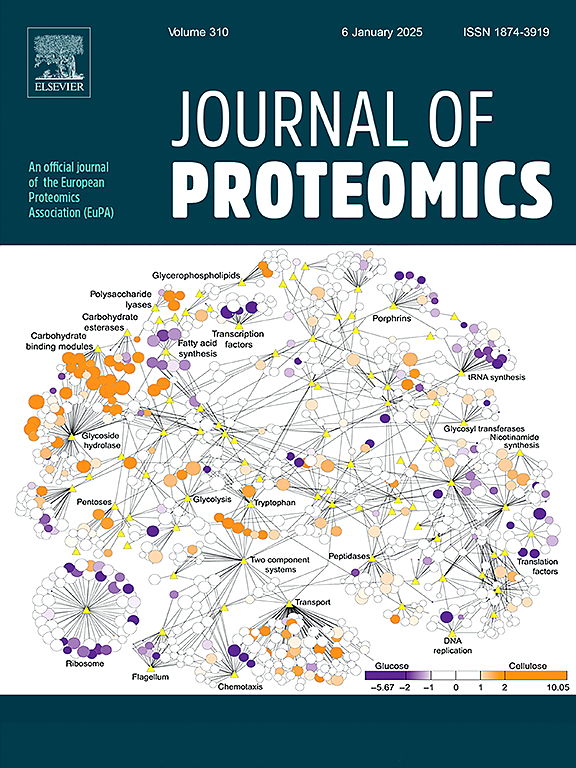精神分裂症患者血清n -糖基化差异的n -糖蛋白组学特征。
IF 2.8
2区 生物学
Q2 BIOCHEMICAL RESEARCH METHODS
引用次数: 0
摘要
糖基化在精神分裂症的神经传递和信号传导中起重要作用;然而,在糖蛋白组水平上的全面表征仍然缺乏。在这里,我们报告了我们在完整n -糖肽分子水平上对精神分裂症患者血清中差异n -糖基化的位点和结构特异性定量n -糖蛋白组学特征,其中获得了全面的定性(n -糖苷,单糖组成和n -聚糖的序列结构)和定量(折叠变化)信息。通过串联质谱标记、液相色谱串联质谱分析和GPSeeker的位点特异性和结构特异性DB搜索,鉴定出7855个完整的n -糖肽,分别对应1914个肽骨架、1997个 n -糖位点和1671个 n -糖蛋白;其中,1088个完整n -糖肽在精神分裂症患者血清中差异表达(相对于健康对照组),其倍数变化不小于1.5。对相应的n -糖蛋白进行功能注释。神经变性和补体通路丰富。这些发现为精神分裂症异常n -糖基化提供了一个全面的位点和结构特异性图像,并可能促进进一步的功能和机制研究。意义:精神分裂症作为一种复杂的精神障碍,在全球范围内影响越来越多的个体,但临床研究一直在努力明确其发病机制。目前的诊断和治疗方法在很大程度上取决于患者的症状和行为,缺乏准确性。n -糖蛋白组学通过探索精神分裂症如何改变体内蛋白质糖基化模式,为理解提供了一个新的维度。研究n -糖蛋白不仅有助于鉴定新的早期诊断生物标志物,而且有助于提高我们对疾病发病机制的认识。这些分子的见解可以为更准确的诊断工具和靶向治疗铺平道路。本文章由计算机程序翻译,如有差异,请以英文原文为准。

Serum N-glycoproteomics characterization of differential N-glycosylation in schizophrenia
Glycosylation plays a crucial role in neurotransmission and signaling in schizophrenia; however, comprehensive characterization at the glycoproteome level is still lacking. Here we report our site- and structure-specific quantitative N-glycoproteomics characterization of differential N-glycosylation in the sera of schizophrenia patients at the molecular level of intact N-glycopeptide, where comprehensive qualitative (N-glycosite, monosaccharide composition and sequence structures of N-glycans) and quantitative (fold change) information are obtained. With tandem mass tag labeling, liquid chromatography tandem mass spectrometry analysis and site- and structure-specific DB search using GPSeeker, 7855 intact N-glycopeptides were identified corresponding to 1914 peptide backbones, 1997 N-glycosites and 1671 N-glycoprotein; where 1088 intact N-glycopeptides were differentially expressed in the sera of schizophrenia patients (relative to healthy control) with fold change of no less than 1.5. Function annotation of the corresponding N-glycoproteins was carried out. Neurodegeneration and complement pathway were enriched. These findings provide a comprehensive site- and structure-specific picture of aberrant N-glycosylation in schizophrenia and may foster further function and mechanism studies.
Significance
Schizophrenia, as a complex mental disorder, is affecting an increasing number of individuals globally, yet clinical research has struggled to clearly elucidate its pathogenesis. Current diagnostic and treatment approaches largely depend on patient symptoms and behavior, which lack precision. N-glycoproteomics offers a new dimension of understanding by exploring how schizophrenia alters protein glycosylation patterns in the body. Investigating N-glycoproteins not only contributes to the identification of novel early diagnostic biomarkers but also enhances our knowledge of disease pathogenesis. These molecular insights could pave the way for more accurate diagnostic tools and targeted therapies.
求助全文
通过发布文献求助,成功后即可免费获取论文全文。
去求助
来源期刊

Journal of proteomics
生物-生化研究方法
CiteScore
7.10
自引率
3.00%
发文量
227
审稿时长
73 days
期刊介绍:
Journal of Proteomics is aimed at protein scientists and analytical chemists in the field of proteomics, biomarker discovery, protein analytics, plant proteomics, microbial and animal proteomics, human studies, tissue imaging by mass spectrometry, non-conventional and non-model organism proteomics, and protein bioinformatics. The journal welcomes papers in new and upcoming areas such as metabolomics, genomics, systems biology, toxicogenomics, pharmacoproteomics.
Journal of Proteomics unifies both fundamental scientists and clinicians, and includes translational research. Suggestions for reviews, webinars and thematic issues are welcome.
 求助内容:
求助内容: 应助结果提醒方式:
应助结果提醒方式:


